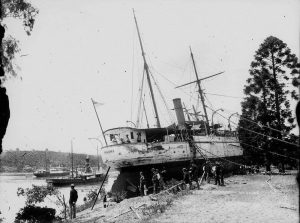- Author
- A.N. Other
- Subjects
- Early warships, History - pre-Federation
- Tags
-
- RAN Ships
- None noted.
- Publication
- June 2011 edition of the Naval Historical Review (all rights reserved)
A previous edition of this magazine reported on the recent (2011) Queensland floods and the refloating in dry dock of the ex HMAS Diamantina. The great Queensland flood of 1893 was however to cause much greater concern to naval authorities.
Following the withdrawal of British garrison troops from the Australian colonies in the early 1870s a report upon colonial defences was prepared by two Royal Engineers, Lieutenant-General Sir William Jervois and Lieutenant-Colonel Peter Scratchley. Shortly afterwards Russia strengthened its Pacific regional forces in particular Imperial Russian Naval forces on the Pacific Station were increased. The ‘Russian Scare’ gave impetus for the colonial governments to implement recommendations of the Jervois report. The recommendations concerning Queensland included the types of ships required stating that suitable vessels were now under construction in England and available at a cost of £ 27,750 each. With the Royal Navy keen to augment its forces on the Australian Station it requisitioning two vessels being built for a South American republic (possibly Chile) and then on-sold these to the Queensland Government.
The vessels chosen were two identical steel built gunboats 120 ft in length, 26 ft beam and drawing 9 ft 6 in and fitted with coal fired compound engines driving twin screws providing a service speed of 10 kts. Despite their small size they were formidably armed with one 8 inch gun forward and a 6 inch gun aft plus three light guns. They were commissioned in 1884 as HMQ Ships Gayundah (Lightning) and Paluma (Thunder). Following trials Paluma’s armament was removed and she was converted for survey duties, sailing from England under the white ensign with a Royal Naval survey crew. Gayundah the Queensland flagship, with a mainly RN steaming crew, sailed under the blue ensign. Both ships arrived safely in Moreton Bay in 1885.
In 1893 following a tropical cyclone a great deluge descended on southern Queensland causing the Brisbane River to burst its banks. On 5th February the river reached its second highest recorded level at the Port Office gauge of 8.35 metres (27 ft 5 in) above low tide levels. The highest recorded level of 8.43 metres (27ft 8 in) occurred in the January 1841 floods. By comparison the 1974 floods peaked at 6.6 metres (22 ft) and the 2011 floods peaked at 4.46 metres (14 ft 7 in) noting the latter was greatly reduced by control of the Ivanhoe Dam.
The impacts of the 1893 great flood were unusual in that the first flood was followed by two more floods of the Brisbane region each within a fortnight, the first on 13 February and the second on 17-19 February each associated with a second and third cyclone.

Courier Mail
At the time of the 1893 great flood both Gayundah and Paluma were moored in the Brisbane River but Paluma undergoing refit was unable to raise steam. Gayundah with assistance from a steam tug was helped into Garden Reach where she was secured. With the current estimated to be running at 10 kts Paluma’s cables parted and she was swept away initially into the path of a coastal steamer Elamang but later both ships plus another coastal vessel Maida were all swept along ending up high and dry near a roadway in the Botanical Gardens. Attempts to tow the ships off were to no avail and contracts were drawn up for a concerted salvage attempt but just as these were about to be signed the second flood occurred (one foot less than the initial flood) placing water around the vessels. A steel hawser was taken from the government steamer Advance who spent from early morning to mid afternoon going from full ahead to full astern attempting to move the ship. Eventually on 19 February with the crew also hauling on kedge anchors Paluma gently slid into deeper waters and was able to be re-secured with minimal damage.
Note: Lieutenant-General Sir William Jervois was an eminent Royal Engineer with considerable experience in coastal defences. He was to become Governor of South Australia and later Governor-General of New Zealand. His colleague Peter Scratchley was another eminent engineer who became commissioner for defence of the Australian colonies and later as Major-General Sir Peter Scratchley was appointed special commissioner for the British Protectorate of New Guinea.




